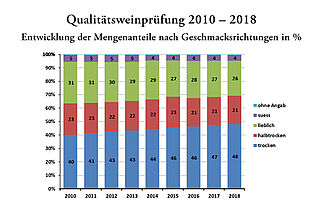Details
Trend naar meer droge wijnen in Duitsland houdt aan
Verder bericht in het Engels.
“We have noticed for many years an almost continuous growth in the production of dry wines. In the year 2000, only a third of wines were bottled in this style. By contrast, the proportion of medium-dry wines at 21 percent has remained largely unchanged for almost 20 years”, explains DWI managing director Monika Reule.
In absolute terms, the share of dry wines equates to a volume of 3.5 million hectolitres. Last year a total of 7.3 million hectolitres of wine was quality-tested, which was distributed across 124,000 lots. The four percent drop in quantity was due to the below-average yields of the 2017 vintage.
White wines accounted last year for 63 percent of German quality and Prädikat wine production. This represents a rise of 1 percentage point compared with last year, as was the case with the share of rosé wines (12%). These increases came at the expense of red wines, which still make up a quarter of the production.
Since 2010, an average of 88 percent of all wines have undergone annual quality control testing in this country. The remaining share is marketed, for example, as table wine or used for the production of Sekt (sparkling wine).
In Germany, all quality and Prädikat wines are subject to a sensory, analytical and labelling examination before receiving approval to be released as such onto the market. Only when all the necessary prerequisites have been fulfilled do they receive an official quality control test number (AP-Nr.), which has to be stated on the label.
Terug Print

